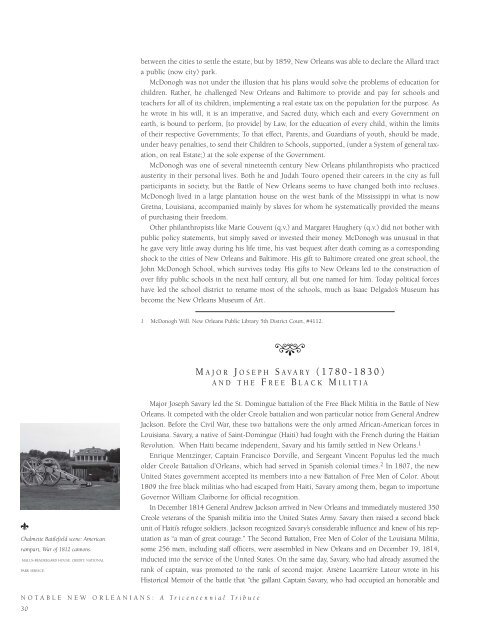Notable New Orleanians: A Tricentennial Tribute
An illustrated history of New Orleans paired with the histories of companies that have helped shape the city.
An illustrated history of New Orleans paired with the histories of companies that have helped shape the city.
You also want an ePaper? Increase the reach of your titles
YUMPU automatically turns print PDFs into web optimized ePapers that Google loves.
etween the cities to settle the estate, but by 1859, <strong>New</strong> Orleans was able to declare the Allard tract<br />
a public (now city) park.<br />
McDonogh was not under the illusion that his plans would solve the problems of education for<br />
children. Rather, he challenged <strong>New</strong> Orleans and Baltimore to provide and pay for schools and<br />
teachers for all of its children, implementing a real estate tax on the population for the purpose. As<br />
he wrote in his will, it is an imperative, and Sacred duty, which each and every Government on<br />
earth, is bound to perform, [to provide] by Law, for the education of every child, within the limits<br />
of their respective Governments; To that effect, Parents, and Guardians of youth, should be made,<br />
under heavy penalties, to send their Children to Schools, supported, (under a System of general taxation,<br />
on real Estate;) at the sole expense of the Government.<br />
McDonogh was one of several nineteenth century <strong>New</strong> Orleans philanthropists who practiced<br />
austerity in their personal lives. Both he and Judah Touro opened their careers in the city as full<br />
participants in society, but the Battle of <strong>New</strong> Orleans seems to have changed both into recluses.<br />
McDonogh lived in a large plantation house on the west bank of the Mississippi in what is now<br />
Gretna, Louisiana, accompanied mainly by slaves for whom he systematically provided the means<br />
of purchasing their freedom.<br />
Other philanthropists like Marie Couvent (q.v.) and Margaret Haughery (q.v.) did not bother with<br />
public policy statements, but simply saved or invested their money. McDonogh was unusual in that<br />
he gave very little away during his life time, his vast bequest after death coming as a corresponding<br />
shock to the cities of <strong>New</strong> Orleans and Baltimore. His gift to Baltimore created one great school, the<br />
John McDonogh School, which survives today. His gifts to <strong>New</strong> Orleans led to the construction of<br />
over fifty public schools in the next half century, all but one named for him. Today political forces<br />
have led the school district to rename most of the schools, much as Isaac Delgado’s Museum has<br />
become the <strong>New</strong> Orleans Museum of Art.<br />
1 McDonogh Will. <strong>New</strong> Orleans Public Library 5th District Court, #4112.<br />
M AJOR J OSEPH S AVARY (1780-1830)<br />
AND THE F REE B LACK M ILITIA<br />
<br />
Chalmette Battlefield scene: American<br />
rampart, War of 1812 cannons.<br />
MALUS-BEAUREGARD HOUSE. CREDIT: NATIONAL<br />
PARK SERVICE.<br />
Major Joseph Savary led the St. Domingue battalion of the Free Black Militia in the Battle of <strong>New</strong><br />
Orleans. It competed with the older Creole battalion and won particular notice from General Andrew<br />
Jackson. Before the Civil War, these two battalions were the only armed African-American forces in<br />
Louisiana. Savary, a native of Saint-Domingue (Haiti) had fought with the French during the Haitian<br />
Revolution. When Haiti became independent, Savary and his family settled in <strong>New</strong> Orleans. 1<br />
Enrique Mentzinger, Captain Francisco Dorville, and Sergeant Vincent Populus led the much<br />
older Creole Battalion d’Orleans, which had served in Spanish colonial times. 2 In 1807, the new<br />
United States government accepted its members into a new Battalion of Free Men of Color. About<br />
1809 the free black militias who had escaped from Haiti, Savary among them, began to importune<br />
Governor William Claiborne for official recognition.<br />
In December 1814 General Andrew Jackson arrived in <strong>New</strong> Orleans and immediately mustered 350<br />
Creole veterans of the Spanish militia into the United States Army. Savary then raised a second black<br />
unit of Haiti’s refugee soldiers. Jackson recognized Savary’s considerable influence and knew of his reputation<br />
as “a man of great courage.” The Second Battalion, Free Men of Color of the Louisiana Militia,<br />
some 256 men, including staff officers, were assembled in <strong>New</strong> Orleans and on December 19, 1814,<br />
inducted into the service of the United States. On the same day, Savary, who had already assumed the<br />
rank of captain, was promoted to the rank of second major. Arsène Lacarrière Latour wrote in his<br />
Historical Memoir of the battle that “the gallant Captain Savary, who had occupied an honorable and<br />
NOTABLE NEW ORLEANIANS: A <strong>Tricentennial</strong> <strong>Tribute</strong><br />
30
















